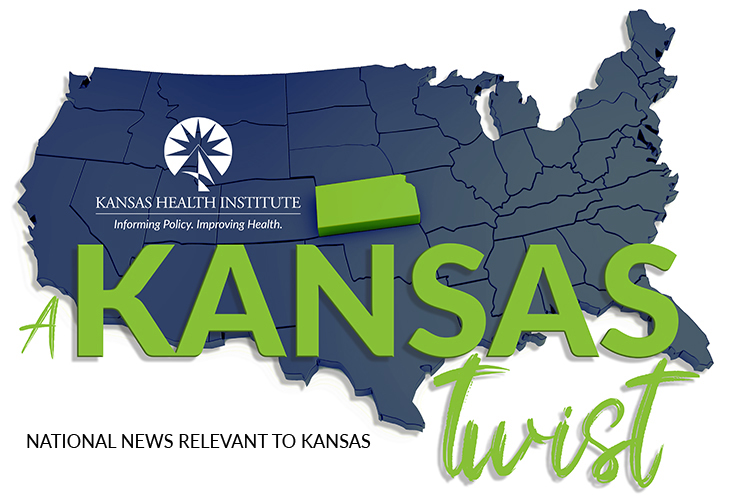Federal legislation tied to the nationwide COVID-19 public health emergency (PHE), first declared on January 29, 2020, and renewed for 90 days a twelfth time on January 11, 2023, incentivized states to maintain eligibility for Medicaid enrollees during the COVID-19 pandemic by increasing federal funding for Medicaid programs. In response, the State of Kansas, and all other states, delayed action on annual reviews, ensuring continuous Medicaid coverage during the pandemic. This policy has resulted in a record 536,222 people – 18.3 percent of the Kansas population – enrolled in Medicaid and the Children’s Health Insurance Program (CHIP), collectively known as KanCare, as of December 2022.
The federal Consolidated Appropriations Act (CAA) 2023, passed in December 2022, decouples the federal funding for maintaining Medicaid eligibility from the COVID-19 PHE. Current guidance from the Centers for Medicare and Medicaid Services (CMS) gives states up to 12 months starting April 1, 2023, to initiate reviews to redetermine eligibility for all Medicaid enrollees. Kansas will be required to process all eligibility casework for KanCare (Kansas Medicaid) that was not acted upon during the PHE. This process is called unwinding.
Some KanCare Enrollees are Expected to Lose Insurance Coverage
The continuous coverage requirement was put in place in March 2020. Before then, 403,521 people were enrolled in KanCare on average each month – 132,701 (24.7 percent) fewer people than were enrolled in December 2022. As eligibility redeterminations resume, many of these Kansans may not be aware of the requirements or may be unable to complete the requirements to maintain coverage, or they may no longer be eligible for Medicaid coverage, and are at risk of becoming uninsured.
Some KanCare Enrollees are at Higher Risk of Disenrollment
Many KanCare enrollees could be subject to churn – the temporary loss of Medicaid coverage in which enrollees are disenrolled and then re-enroll within a short period of time. Many Medicaid enrollees experience frequent changes in income or circumstances which make them temporarily ineligible for coverage. Some also lose coverage during the renewal process because they don’t submit required paperwork in a timely manner. Many may experience barriers to enrollment, including administrative issues (e.g., incomplete enrollment forms) and communication barriers. Certain Kansans could be at higher risk of losing coverage during unwinding, including people from racial and ethnic minority groups, especially Hispanic or Latino individuals, young adults, and people with disabilities.
Research by the Assistant Secretary for Planning and Evaluation (ASPE) suggests that, across the country, children and young adults, as well as Latino and Black individuals, will be disproportionately affected during unwinding. They find that children are more likely to be affected by churn and young adults (age 18 to 34) are more likely to no longer be eligible.
Additionally, ASPE found that Latino individuals comprise over one-quarter of those predicted to be ineligible for Medicaid and over one-third of those predicted to experience churn, while Black individuals comprise 14 percent of those predicted to lose Medicaid eligibility and 15 percent of those predicted to experience churn. People with income between 138 percent and 250 percent of the federal poverty level (FPL) comprised nearly 40 percent of those predicted to be ineligible for Medicaid, while those with income less than 100 percent FPL comprise over half of those predicted to experience churn.
Some KanCare Enrollees Live in Areas Where the Risk of Disenrollment is Higher
In 2022, the Community Care Network of Kansas commissioned the Kansas Health Institute (KHI) to study Medicaid enrollment during the pandemic and identify neighborhoods that may be most at risk of disenrollment once annual reviews and eligibility redeterminations resume. Using enrollment data provided by the Kansas Department of Health and Environment (KDHE), KHI identified neighborhoods where KanCare enrollees may be at higher risk of disenrollment once unwinding begins. Two criteria were used to evaluate neighborhoods: 1) excess growth in coverage, and 2) churn.
- New enrollees in neighborhoods where KanCare enrollment grew more quickly during the pandemic than before the pandemic are assumed to be at higher risk of disenrollment once unwinding begins.
- New enrollees in neighborhoods that have experienced higher rates of churn, where people re-enrolled in Medicaid within one year after being disenrolled during an eligibility redetermination, are assumed to be at a higher risk of being disenrolled once unwinding begins.
To determine areas in Kansas with a higher risk of disenrollment, KHI analyzed data from February 2020 to June 2022. During that timeframe, there were 97,977 new KanCare enrollees statewide, about half (53.3 percent) of them living in neighborhoods at higher risk of disenrollment. While enrollees across the state will be affected by unwinding, enrollees living in these areas are more likely to be impacted. Figure 1 shows the distribution by KDHE region of the enrollment increase and how many of those new enrollees are at higher risk of disenrollment once unwinding begins. Most new enrollees, including those at higher risk of disenrollment, are in Northeast Kansas and South Central Kansas, the most populous areas of the state. While fewer in number, there also was a significant increase in new enrollees in Southwest Kansas (28.1 percent).
KHI also conducted this analysis at the county level and found that Sedgwick County had the most new enrollees, including those who are at a higher risk of disenrollment. For the full analysis, please see Change in KanCare Enrollment by County, February 2020 – June 2022.

